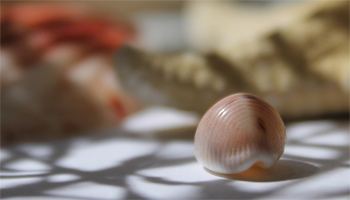The Big Brick Review
Building on the narrative of our lives...one brick at a time.

Vault Beach, 1996
by Jenny Lloyd
MY GROWN-UP CHILDREN and I sit apart from each other on the sand. It is sand only by courtesy, a false promise gleaming seductively from the cliff walk. In fact it is tiny white and gray pieces of gravel, coarse to the touch, unpleasant to walk on barefoot. Close up it is a dull gray on the surface but sparkles in the dampness we uncover when we comb it gently with our fingers, looking for a glimpse of pale pink. We are searching for cowry shells no bigger than my fingernail, folded mounds, crimped at the edges, tiny pink-striped calzones. I am the person who knows they are there, who brings that knowledge back to Vault Beach where perhaps it has been forgotten.
I spent many childhood days staring at surely not this very sand but its ancestor, eroded from the granite Cornish cliffs. Perhaps it is the same sand—it seems indestructible. No other Cornish beach I know of has granite sand. Why not? Perhaps some quirk of the tide sifts the fine from the coarse, and dumps the gravel here, on the long curve from the rocky Gorran headland to the smooth gaunt Dodman point, a deceptively long distance I don’t think I ever walked. Is there a connection between the granite sand and the cowry shells, also unique to this beach? They are smaller and squatter than the ones I have seen in American necklaces, the ones Africans used (use?) for money. I have never found a cowry shell with a creature in it. Do they float here only when their inhabitants are dead? Is Vault Beach perhaps the Sargasso Sea of cowries, and our shells the relics of those that did not make it back?
In my memory we found cowries easily. We carried a small handful up the steep path to our cliff-top school, a gray slate house with small-paned windows reflecting the ocean’s moods, snuggled in a hollow on the cliff top, protected by a hedge of fuchsias. Today I find many other small shells that I remember—yellow or terracotta snails, limpets shaped like coolie hats, my favorite spiral winkles—but no cowries. Were they this rare fifty years ago? Or has something changed? Perhaps the tides have shifted with global warming, although the granite sand is still here. Perhaps cowries are dying out in Africa. Maybe someone gathers the shells and glues them together into tourist souvenirs. It could be that the ocean deposited a finite number millennia ago and we picked up most of them. The beach is shelled out.
I look ahead to where Tom and Jane have staked their claims. I showed them how to sift for shells in Majorca when they were small children twenty-five years ago. A storm the night before had left our hotel’s beach a shrunken mess of stinking seaweed so we rented a double stroller and walked to a tiny inlet sheltered from the still-brisk wind. We hunkered down between rocks like Vault’s, where the ebbing tide uncovered pools with sea anemones and salt-water shrimp. The Majorca sand had a hint of coarseness and an area of fine pebbles that reminded me of my childhood siftings. I showed Tom and Jane how to rake the sand, to look carefully and slowly, to distinguish shells from pebbles, to be patient. We excavated a small pile, enough to satisfy, and took them home as souvenirs, spread out on shelves for years.
Tom and Jane have not forgotten. We have not traveled together for a while, but have as usual fallen into easy companionship. I am still the guide, I control the itinerary, and we resume as adults the pattern we had on vacation in Austria, in France, in Majorca those many years ago. All I taught them in their childhoods I learned here in mine. In the mornings, in the schoolroom atop the cliff, Miss Rapley encouraged me to love learning and let me surge ahead by myself. In the afternoons, on this beach, walking along these cliffs, I learned to appreciate the astounding beauty of the place, and to look for and name flowers in the hedgerows, sea creatures in the tide pools, shells. I instilled these passions in my children, I prepared them to hunt patiently for cowries. They choose to do so because I learned here that it was fun. I am passing on Miss Rapley’s legacy.
I shift locations a little and turn my attention to an area of tiny pebbles. I begin to sift again—and there it is, a cowry, exactly as I remember. I brush off the sand and jump up to show Tom and Jane, who are encouraged. A family passes by, parents, two small children, and ask me what I am doing. Looking for cowries, I say, and show them my find. They are interested—they come here often but never knew to look. They drop their bags and join the search. But we find no more and decide to give up and go look for a Cornish cream tea. We wind back up through the yellow gorse, pink vetch, and rosy ragged robin that have bloomed here in summer far longer than I remember. I look over my shoulder and see the family has recruited others to the hunt. The tradition is safe. If there are cowries left to find.
Jenny Lloyd is a retired historian and recovering from academic writing. She grew up in Cornwall, England, and is writing a memoir of her childhood and adolescence on a farm there.
"Vault Beach, 1996" photo © 2014 Gregory Gerard
Tweet < back to the Review.
